
Lichenology is the branch of mycology that studies the lichens, symbiotic organisms made up of an intimate symbiotic association of a microscopic alga with a filamentous fungus. Lichens are chiefly characterized by this symbiosis.

Rhizocarpon is a genus of crustose, saxicolous, lecideoid lichens in the family Rhizocarpaceae. The genus is common in arctic-alpine environments, but also occurs throughout temperate, subtropical, and even tropical regions. They are commonly known as map lichens because of the prothallus forming border-like bands between colonies in some species, like the common map lichen.
Maria Cengia Sambo was an Italian botanist, specializing in lichenology. Her work in the early twentieth century on the nature of the lichen symbiosis along with collection of many specimens and records of lichen distributions was particularly significant.
Peter Crittenden is a British lichenologist. His research largely concerns the ecophysiology of lichens. Crittenden is known for using new techniques to study lichens, such as the use of 3D printing and X-ray computed tomography to study lichen structure and development. He served as the senior editor of the scientific journal The Lichenologist from the years 2000–2016; and still serves on the editorial board for the journal Fungal Ecology. Crittenden was the president of the British Lichen Society in 1998–1999, and president of the International Association for Lichenology from 2008 to 2012. He was awarded the Acharius Medal at the 10th International Mycological Congress in Bangkok in 2014, for his lifetime achievements in lichenology.
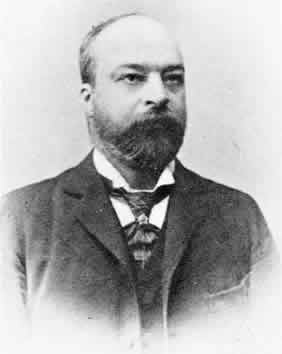
Antonio Jatta was an Italian politician and lichenologist. After completing his secondary studies at the Classical Lyceum Umberto I in Naples, at the age of 22 he graduated with honours in natural history at the University of Naples and in agriculture at the Royal Higher School of Agriculture in Portici. He was a wealthy landowner who published Flora Italica Cryptogama in several volumes from 1900 to 1909. Jatta identified the lichens that were given in the 1915 list of the lichens of the Maltese Islands, compiled by the botanists Carlo Pietro Stefano Sommier and Alfredo Caruana Gatto. A 1962 publication by William Culberson noted that most of his subgeneric names from the Flora Italica Cryptogama had not been included in Alexander Zahlbruckner's influential 10-volume work Catalog Lichenum Universalis (1922–1940), nor in Elke Mackenzie's 1963 followup work Index Nominum Lichenum. Culberson catalogued 467 of Jatta's names to avoid the future publication of "superfluous or otherwise illegitimate names".

Ruggero Tomaselli was an Italian botanist. He introduced the study of phytosociology to Italy.
Helmut Mayrhofer is an Austrian lichenologist. He is known for his expertise on the lichen family Physciaceae and his studies of the lichen flora of the Balkan Peninsula, the Alps, and other regions.
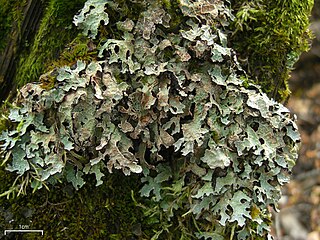
Parmelia barrenoae is a species of foliose lichen in the large family Parmeliaceae. It was formally described as a new species in 2005. Before this, it was lumped together as one of several lichens in the Parmelia sulcata group—a species complex of genetically distinct lookalikes. Parmelia barrenoae is widely distributed, occurring in Europe, western North America, Africa, and Asia.

Pseudosagedia is a genus of corticolous (bark-dwelling) lichens in the family Trichotheliaceae. It was first circumscribed as a section of genus Arthopyrenia by Swiss botanist Johannes Müller Argoviensis in 1862. Maurice Choisy elevated it to distinct generic status in 1949. Pseudosagedia was little used until, in 1995, Josef Hafellner and Klaus Kalb resurrected the genus to contain members of the Porina nitidula species group with the perithecial pigment called Pseudosagedia-violet and lacking setae.

Thelenellaceae is a family of lichen-forming fungi. It is the sole family in the monotypic order Thelenellales, and contains three genera and about 50 species.
Josef Poelt was a botanist, bryologist and lichenologist. He held the chair in Systematic Botany and Plant Geography at the Free University of Berlin and then was head of the Botanical Institute and Botanical Garden of Graz University, Austria.
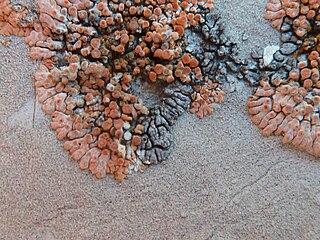
Verrucula arnoldaria is a rare species of lichenicolous (lichen-dwelling) lichen in the family Verrucariaceae. It grows parasitically on the thallus of the rock-dwelling, crustose lichen Calogaya arnoldii. The species was formally described as new to science in 2007 by lichenologists Père Navarro-Rosinés and Claude Roux, from specimens collected in Vaucluse, France. It has also been recorded from Italy. The lichen has a thick brownish-grey, areolate thallus that roughly maintains the shape of its underlying host. The thallus is covered with a crystalline pruina. It makes ellipsoid spores that measure up to about 15 μm long. Its host grows on calciferous rocks and calciferous schists.
Maronella is a genus of lichens of uncertain familial and ordinal placement in the class Lecanoromycetes. The genus was circumscribed in 1959 by German lichenologist and lichen chemist Maximilian Steiner with Maronella laricina assigned as the type, and at that time, only species. This lichen is rare, having only been recorded from Austria and Spain. M. coreana, known only from type collection in South Korea, was added to the genus in 2015. Both species grow on bark and have a crust-like thallus.
Diromma is a monotypic fungal genus in the family Roccellaceae. It contains the single species Diromma dirinellum, a rare crustose lichen that grows as a parasite on the lichen Dirina ceratoniae. It has a distribution restricted to the Mediterranean Basin.
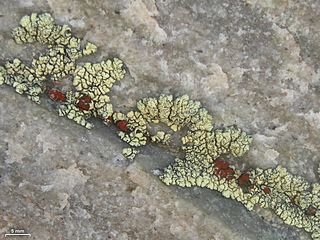
Erichansenia epithallina is a species of saxicolous (rock-dwelling), crustose lichen in the family Teloschistaceae. It is also a lichenicolous lichen species, meaning that it grows on other lichens. Many host genera have been recorded. It occurs in Europe and North America, including Arctic regions.
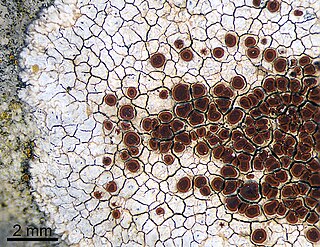
Kuettlingeria erythrocarpa is a species of saxicolous (rock-dwelling), crustose lichen in the family Teloschistaceae.

Flavoplaca limonia is a species of saxicolous (rock-dwelling), crustose lichen in the family Teloschistaceae. It was first formally described as a new species in 1994 by lichenologists Pier Luigi Nimis and Josef Poelt. Ulf Arup and colleagues transferred the taxon to the genus Flavoplaca in 2013, following a molecular phylogenetics-based restructuring of the family Teloschistaceae.
Caloplaca rinodinae-albae is a lichenicolous (lichen-dwelling) species of crustose lichen in the family Teloschistaceae, first described in 1987. This species is unique for its parasitic growth on the lichen Helmutiopsis alba. Characteristics of the lichen include its small, rounded, pale orange thalli and its ability to form larger patches through the confluence of individual thalli.

Enchylium polycarpon, commonly known as the shaly jelly lichen, is a species of foliose lichen in the family Collemataceae. Formerly known as Collema polycarpon, it was renamed in 2013 as part of a taxonomic revision. This lichen has a widespread global distribution, occurring in various regions of North America, Europe, Africa, and Asia.
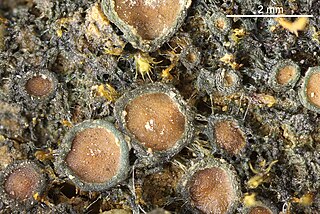
Enchylium limosum, commonly known as lime-loving tarpaper lichen, is a species of crustose to subfoliose lichen in the family Collemataceae. This unique lichen species possesses a gelatinous thallus with a dark coloration, contributing to its distinctive appearance. It is found thriving in a diverse array of habitats spanning temperate to boreal-montane regions across Europe, North America, Africa, and Asia.












